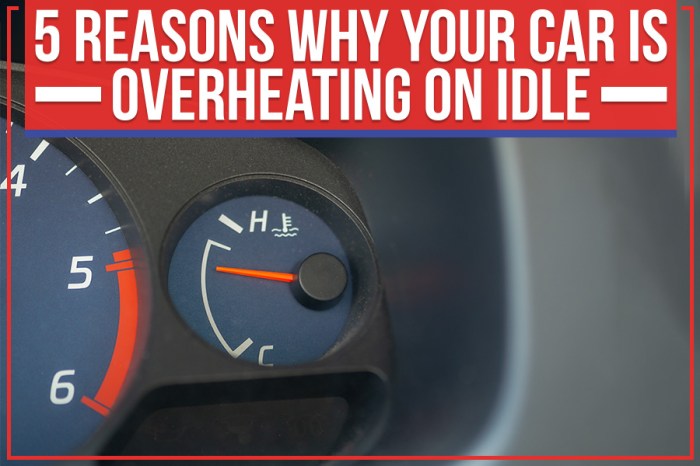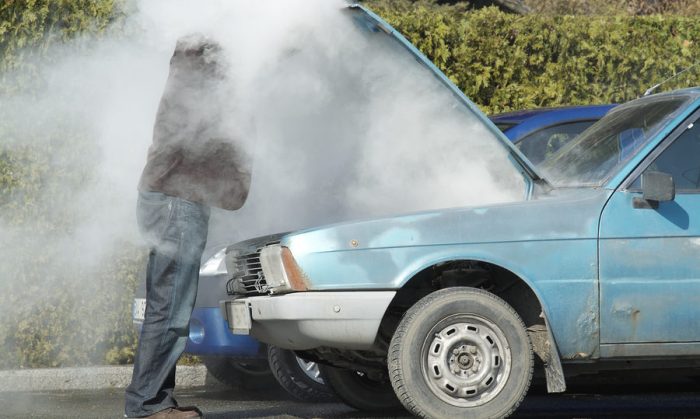Why is my truck overheating when towing? That’s a seriously frustrating question, especially when you’re hauling a load. Overheating can range from a minor inconvenience to a major breakdown, leaving you stranded and potentially causing significant engine damage. This guide dives into the common culprits behind towing-related overheating, from simple fixes like checking your coolant levels to more complex engine issues.
We’ll cover everything you need to know to keep your truck cool under pressure (and on the road!).
Understanding why your truck overheats while towing requires looking at a few key areas: your cooling system’s health, the increased stress towing puts on your engine, and potential problems within the engine itself or your transmission. We’ll explore each of these, offering practical advice and troubleshooting steps so you can get back on the road safely and efficiently.
Cooling System Issues
Overheating while towing is a serious problem that can quickly lead to engine damage. A properly functioning cooling system is crucial, especially under the increased stress of towing. Understanding the components and how they work together is key to diagnosing and fixing overheating issues.
Cooling System Components and Their Functions
The truck’s cooling system is a complex network of parts working in harmony to regulate engine temperature. A failure in any one component can compromise the entire system, leading to overheating.
| Component | Function | Common Failure Points | Symptoms of Failure |
|---|---|---|---|
| Radiator | Dissipates heat from the coolant by passing it through a network of fins exposed to airflow. | Clogged fins, leaks in the radiator core or tanks, damaged or corroded components. | Overheating, especially under heavy load; coolant leaks; low coolant level. |
| Water Pump | Circulates coolant through the engine and radiator. | Worn bearings, impeller failure, leaks in the pump housing. | Overheating; weak or no coolant flow; coolant leaks. You might hear a whining noise from the pump. |
| Thermostat | Regulates coolant flow to maintain optimal engine temperature. It opens and closes to allow coolant to circulate when needed. | Sticking open or closed; internal failure. | Engine takes too long to reach operating temperature (stuck open); overheating (stuck closed). |
| Hoses | Carry coolant between the engine, radiator, and other components. | Cracks, holes, or collapses due to age, heat, or wear. Clamps can also fail. | Coolant leaks; visible damage to hoses; overheating. |
| Coolant | Absorbs and transfers heat from the engine to the radiator. | Improper coolant mixture; low coolant level; contamination with oil or other substances. | Overheating; poor engine performance; white smoke from the exhaust (indicates coolant burning). |
Coolant Types and Properties
Choosing the right coolant is essential for optimal cooling system performance. Different coolants offer varying levels of protection and longevity.Coolant types vary significantly in their properties and performance. The two most common types are:
- Conventional Coolant (IAT): This is typically a 50/50 mix of ethylene glycol and water, often containing corrosion inhibitors. It generally needs to be changed every two years or 24,000 miles.
- Extended Life Coolant (OAT or HOAT): These coolants are designed for longer service intervals (5 years or 150,000 miles). They use different inhibitor technologies that provide better protection against corrosion and cavitation.
Here’s a comparison:
- Conventional Coolant (IAT):
- Advantages: Readily available and relatively inexpensive.
- Disadvantages: Shorter lifespan, requiring more frequent changes.
- Extended Life Coolant (OAT or HOAT):
- Advantages: Longer service intervals, better corrosion protection.
- Disadvantages: More expensive than conventional coolant; mixing with conventional coolant can reduce effectiveness.
Checking Coolant Levels and Identifying Leaks
Regularly checking your coolant level is crucial for preventing overheating. Leaks can develop gradually, and early detection is key.A step-by-step guide to checking coolant levels and identifying leaks:
- Allow the engine to cool completely before attempting to check the coolant level. Hot coolant can cause severe burns.
- Locate the coolant reservoir. This is usually a translucent plastic tank with markings indicating minimum and maximum levels. A diagram showing the location of the coolant reservoir, typically a translucent plastic tank near the radiator, with arrows pointing to the minimum and maximum fill lines. The tank will likely have a cap that needs to be unscrewed carefully.
- Carefully remove the reservoir cap. Be prepared for some pressure release as the cap is opened. A close-up image showing the cap and the careful process of opening it, highlighting the need to avoid spills or burns.
- Inspect the coolant level. The level should be between the minimum and maximum marks. A picture showing the coolant level within the reservoir, clearly indicating the minimum and maximum markings.
- Inspect the radiator and hoses for leaks. Look for wet spots, stains, or dripping coolant. An image showing a typical radiator and its surrounding hoses, highlighting areas where leaks might occur.
- Check the underside of the vehicle for any signs of coolant leaks. A diagram depicting the underside of a truck with arrows pointing to common areas where coolant leaks may be visible, such as the water pump, radiator, and hoses.
- If a leak is suspected, take your truck to a mechanic for professional diagnosis and repair. This is important to prevent further damage to your engine.
Towing-Specific Overheating Factors

Towing significantly increases the thermal load on your truck’s engine, pushing it far beyond its normal operating parameters. This isn’t just about hauling extra weight; it’s a complex interplay of physics that can quickly lead to overheating if not properly managed. Understanding these factors is crucial for preventing costly repairs and potentially dangerous situations.When you tow, you’re essentially adding a massive amount of resistance to your engine’s work.
This resistance manifests in two primary ways: increased friction and increased aerodynamic drag. The added weight of the trailer increases friction within the engine itself (moving parts rubbing against each other), in the transmission, and in the drivetrain components like the axles and bearings. This friction converts mechanical energy into heat, raising the engine’s temperature. Simultaneously, the larger profile created by the truck and trailer increases aerodynamic drag – the resistance of air against the moving vehicle.
Overcoming this drag requires more power from the engine, leading to further heat generation. Think of it like this: the harder your engine has to work, the more heat it produces.
Increased Thermal Load During Towing
The increased thermal load during towing is directly proportional to the weight of the trailer and the grade of the road. Heavier loads and steeper inclines demand significantly more power from the engine, resulting in a much higher rate of heat generation. This heat needs to be effectively dissipated by the cooling system to prevent overheating. Failure to do so can lead to engine damage, potentially requiring expensive repairs.
For example, towing a heavy boat uphill on a hot summer day puts an extreme strain on the cooling system. The combination of increased friction from the heavy load and the added effort required to climb the incline drastically increases the engine’s operating temperature.
So your truck’s overheating while towing? That usually means a cooling system issue, like a failing radiator or low coolant. Maybe you need a more efficient ride altogether; check out this list of Best hybrid SUVs for off-roading 2025 for future hauling needs. But for now, make sure your towing capacity matches your load and that your truck’s cooling system is properly maintained to avoid future overheats.
Uphill vs. Downhill Towing
The risk of overheating differs significantly depending on whether you’re towing uphill or downhill.
Yo, so your truck’s overheating while towing? That totally sucks. It could be a few things, but one major factor is exceeding your truck’s towing capacity. Check out this link to see how much your Chevy 2500HD can actually handle: How much weight can a Chevy 2500HD tow? Overloading puts serious strain on the engine and cooling system, leading to overheating.
Make sure you’re not exceeding the limits; otherwise, you’re gonna be calling a tow truck yourself!
- Uphill Towing: Uphill towing presents the greatest risk of overheating. The engine works harder to maintain speed against gravity, generating substantially more heat. The increased demand on the engine, coupled with reduced airflow through the radiator (due to the angle of the incline), makes effective heat dissipation more challenging.
- Downhill Towing: Downhill towing generally presents a lower risk of overheating. Gravity assists the vehicle, reducing the engine’s workload. However, prolonged downhill travel can still lead to overheating if the engine’s braking systems (such as the engine brake or exhaust brake) are not used effectively to control speed and prevent excessive heat buildup in the transmission and brakes.
Overheating of the brakes, in particular, is a significant concern during long downhill stretches.
Exacerbating Factors During Towing
Several external factors can significantly exacerbate the risk of overheating while towing.
- Ambient Temperature: High ambient temperatures reduce the cooling system’s efficiency. The air surrounding the radiator is already hot, making it harder for the radiator to transfer heat effectively. Towing in extreme heat can quickly push the engine beyond its safe operating temperature.
- Towing Speed: While it might seem counterintuitive, higher towing speeds can increase the risk of overheating. Increased speed leads to greater aerodynamic drag, generating more heat. Conversely, extremely slow speeds can also be problematic, as the airflow through the radiator might be insufficient to dissipate the heat effectively.
- Trailer Brake Condition: Faulty or improperly adjusted trailer brakes can lead to excessive heat buildup in the trailer’s wheels and axles. This can indirectly affect the tow vehicle’s cooling system, as the increased stress on the towing components can contribute to higher engine temperatures.
Engine-Related Problems
Overheating while towing isn’t always about the cooling system; sometimes, the problem lies within the engine itself. A malfunctioning engine can generate excessive heat, overwhelming even a perfectly functioning cooling system, especially under the stress of towing. This section will explore how engine issues contribute to overheating and how to diagnose them.
A number of engine problems can cause overheating when towing. Low compression, for example, means the engine isn’t burning fuel as efficiently as it should. This incomplete combustion generates more heat than normal, putting extra strain on the cooling system. Similarly, clogged fuel injectors can lead to a rich or lean fuel mixture, both of which can cause inefficient combustion and increased heat production.
These issues are exacerbated by the increased load placed on the engine during towing, pushing it beyond its capacity to dissipate heat effectively.
Symptoms of Engine Problems Contributing to Overheating
Recognizing the symptoms of engine problems is crucial for accurate diagnosis and repair. The following table Artikels some key indicators:
| Symptom | Possible Cause |
|---|---|
| Reduced engine power | Low compression, clogged fuel injectors, worn piston rings |
| Rough idling or misfiring | Clogged fuel injectors, faulty spark plugs, ignition system problems |
| Excessive smoke from the exhaust (blue, black, or white) | Burning oil (blue smoke), rich fuel mixture (black smoke), coolant leak (white smoke) |
| Overheating, even at low speeds | Low compression leading to inefficient combustion, restricted exhaust system |
| Decreased fuel economy | Low compression, clogged fuel injectors, air leaks in the intake system |
Diagnosing Engine-Related Overheating Issues
Diagnosing engine-related overheating requires a systematic approach. Here’s a step-by-step procedure:
- Check the coolant level: Low coolant levels can indicate a leak, which should be addressed immediately. A pressure test can help pinpoint the source of the leak.
- Inspect the engine for leaks: Look for visible leaks around the engine block, hoses, and radiator. Pay close attention to the head gasket, a common source of leaks.
- Perform a compression test: This test measures the pressure in each cylinder. Low compression in one or more cylinders indicates a problem with the piston rings, valves, or head gasket.
- Check fuel injector performance: A fuel injector cleaning or replacement might be necessary if the injectors are clogged or malfunctioning. A fuel pressure test can help determine if the fuel system is delivering adequate pressure.
- Inspect the exhaust system: A restricted exhaust system can cause back pressure, leading to increased engine temperatures. Look for blockages or damage.
- Consult a mechanic: If you’re not comfortable performing these checks yourself, consult a qualified mechanic for a professional diagnosis and repair.
Maintenance and Prevention: Why Is My Truck Overheating When Towing?
Preventing your truck from overheating while towing requires a proactive approach to maintenance. Regular checks and scheduled servicing are crucial for ensuring the longevity of your vehicle and preventing costly repairs down the line. Neglecting these preventative measures can lead to significant damage, including warped engine blocks, blown head gaskets, and even catastrophic engine failure. By implementing a solid maintenance plan, you can significantly reduce the risk of overheating and keep your truck running smoothly, even under the stress of heavy towing.
Preventative Maintenance Schedule
A regular maintenance schedule is vital for preventing overheating issues. Failing to address even minor problems can snowball into major headaches. This schedule should be tailored to your towing frequency and the conditions under which you tow. However, these guidelines provide a solid foundation.
- Coolant Flush: Every 24 months or 24,000 miles, depending on your vehicle’s manufacturer’s recommendations. A coolant flush removes contaminants and ensures proper coolant flow. A dirty coolant system is less efficient at transferring heat.
- Hose and Belt Inspection: Every 6 months or 6,000 miles. Visually inspect all hoses for cracks, bulges, or leaks. Check belts for wear, fraying, or cracks. Replace any damaged components immediately. Look for signs of hardening or excessive wear, which indicates a need for replacement.
Hoses should be pliable and free from any visible damage. Belts should be taut and show no signs of cracking or fraying.
- Radiator Fan Check: Every 6 months or 6,000 miles. Ensure the radiator fan is functioning correctly and engaging when the engine temperature rises. Listen for unusual noises and visually inspect the fan blades for damage. A faulty fan can severely hinder the cooling system’s ability to dissipate heat.
- Thermostat Check: Every 24 months or 24,000 miles. The thermostat regulates coolant flow. A malfunctioning thermostat can prevent proper cooling. It should open and close as designed to regulate engine temperature.
Towing Oil Weight Selection
Using the correct weight of motor oil designed for towing is critical. The oil acts as a lubricant and coolant, reducing friction and heat within the engine. Using the wrong weight can have serious consequences.The consequences of using the incorrect oil weight can range from reduced fuel economy and increased engine wear to complete engine failure. For instance, using an oil that is too thin might not provide adequate lubrication under heavy loads, leading to increased friction and heat, potentially causing overheating.
Conversely, using an oil that is too thick can restrict oil flow, again leading to overheating and potentially damaging engine components. Always consult your owner’s manual for the recommended oil weight for towing. It will typically specify a higher viscosity grade (e.g., 15W-40) for towing applications compared to normal driving conditions.
Preventative Maintenance Checklist for Towing Trucks
This checklist should be performed before each towing trip and regularly as part of your maintenance schedule.
- Coolant Level: Check the coolant level in the overflow reservoir. The coolant should be within the marked range. Visual Description: The reservoir is typically a translucent plastic tank with minimum and maximum fill lines clearly marked.
- Engine Oil Level: Check the engine oil level using the dipstick. The oil level should be between the minimum and maximum marks. Visual Description: The dipstick is a metal rod with markings indicating the oil level. Pull it out, wipe it clean, reinsert, and check the level.
- Transmission Fluid Level: Check the transmission fluid level according to your vehicle’s manual. Visual Description: The location and method of checking vary depending on the vehicle, consult your owner’s manual. Look for leaks or discoloration.
- Tire Pressure: Check and inflate tires to the recommended pressure for towing, usually found on a sticker inside the driver’s side doorjamb or in your owner’s manual. Visual Description: Use a tire pressure gauge to check the pressure in each tire. Proper inflation is crucial for safe and efficient towing.
- Brake System Inspection: Visually inspect brake pads and rotors for wear. Check brake fluid level. Visual Description: Brake pads are located behind the wheels and can be inspected by removing the wheel. Brake rotors are the circular metal discs that the pads press against. Brake fluid level is checked in a reservoir, usually located under the hood.
- Lights and Signals: Verify that all lights (headlights, taillights, brake lights, turn signals) and towing-related signals (if applicable) are functioning correctly. Visual Description: Test each light individually to ensure it illuminates properly. Check the trailer lights (if using a trailer) as well.
Transmission Issues

Overheating isn’t always just an engine problem; sometimes, trouble in the transmission can send temperatures soaring. A malfunctioning transmission can indirectly cause engine overheating by increasing the load on the engine and reducing its efficiency. This increased workload forces the engine to work harder, generating more heat than it can dissipate, ultimately leading to overheating.Transmission problems can significantly impact engine performance and cooling capacity.
When the transmission isn’t functioning correctly, it can create a cascade effect, leading to increased friction, reduced power transfer, and ultimately, engine overheating. Understanding how these issues connect is crucial for diagnosing and resolving overheating concerns, especially when towing.
Transmission Fluid Level and Condition, Why is my truck overheating when towing?
Checking your transmission fluid is a simple yet vital step in maintaining your vehicle and preventing overheating issues. Low fluid levels or contaminated fluid dramatically reduce the transmission’s ability to lubricate and cool internal components, leading to increased friction and heat. This extra heat can be transferred to the engine, contributing to the overall overheating problem.
- Locate the Transmission Dipstick: The transmission dipstick is usually located near the engine, often with a different colored handle than the engine oil dipstick. Consult your owner’s manual if you’re unsure of its location.
- Check the Fluid Level: With the engine running and warmed up (but not overheated!), remove the dipstick, wipe it clean with a lint-free cloth, and reinsert it fully. Remove it again and check the fluid level against the markings on the dipstick. The fluid level should fall within the “full” range.
- Assess Fluid Condition: Examine the fluid’s color and smell. New transmission fluid is typically bright red or pink. If the fluid is dark brown, burnt, or smells burnt, it indicates significant degradation and needs immediate attention. A milky appearance suggests the presence of water, a serious problem requiring professional repair.
- Add Fluid (If Necessary): If the fluid level is low, add the correct type of transmission fluid as specified in your owner’s manual. Never overfill the transmission.
Symptoms of Transmission Problems Leading to Overheating
Several symptoms can indicate transmission problems that might cause or contribute to engine overheating. These symptoms, if ignored, can escalate the problem and lead to costly repairs. Early detection is key to preventing major issues.
- Slipping or delayed engagement: The transmission might hesitate to shift gears or slip between gears, causing the engine to rev higher than normal without corresponding increases in speed. This increased engine load generates excess heat.
- Rough shifting: Harsh or jarring shifts can indicate internal transmission problems, increasing friction and heat.
- Whining or grinding noises: These sounds usually indicate worn-out internal components, generating excessive heat through friction.
- Overheating warning light: While this might seem obvious, it’s crucial to remember that the overheating warning light doesn’t always directly point to engine problems; transmission issues can trigger it as well.
- Low transmission fluid level: As previously mentioned, low fluid significantly reduces lubrication and cooling, leading to increased heat generation.
Concluding Remarks

So, your truck’s overheating while towing? Don’t panic! By systematically checking your cooling system, examining your engine and transmission for problems, and implementing a preventative maintenance plan, you can significantly reduce the risk of overheating and keep your towing adventures smooth. Remember, regular maintenance is key—it’s much easier (and cheaper!) to prevent problems than to fix them after a breakdown.
Stay cool out there!









